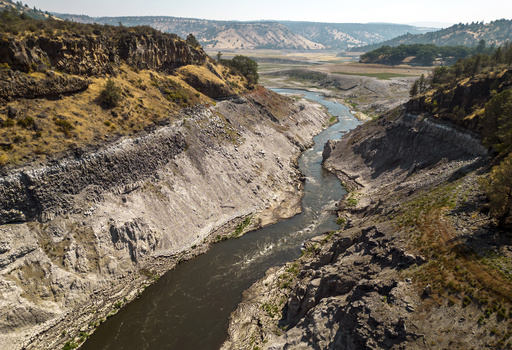
A large female Chinook salmon thrashes in the shallow river water, energetically using her tail to create a nest in the riverbed, her shiny body reflecting sunlight. Nearby, male salmon are seen vying for space to fertilize the eggs, competing against one another in an age-old ritual.
These vibrant scenes are a dream come true for local indigenous tribes who have long worked to dismantle four hydroelectric dams obstructing the passage of salmon along over 400 miles of the Klamath River and its tributaries that run along the Oregon-California border.
Just under a month after this historic dam removal initiative, which stands as the largest of its kind in U.S. history, salmon are beginning to return to spawn in streams that have remained inaccessible to them for generations. Videos captured by the Yurok Tribe illustrate that hundreds of salmon have successfully navigated to tributaries between the former Iron Gate and Copco dams, signaling a promising development for the revitalized waterway.
“The sight of salmon spawning above the old dam sites fills my soul with joy,” expressed Joseph L. James, chairman of the Yurok Tribe. “Our salmon are coming back home. For decades, tribes in the Klamath Basin have fought tirelessly to make this day happen for our future generations, ensuring they inherit a healthier river ecosystem from the mountain sources to the ocean.”
Spanning from its origins in southern Oregon through the lush forests of northern California before reaching the Pacific Ocean, the Klamath River is now witnessing a resurgence of salmon activity.
The culmination of the dam removal project on October 2 marked a key triumph for local tribes. Over the years, through protests, testimonies, and legal actions, they highlighted the environmental destruction caused by the dams, particularly regarding salmon populations, which had become isolated from their natural habitats and had been declining in alarming numbers due to deteriorating water quality.
Following the removal of the dams, concentrations of harmful algae blooms have decreased, noted Toz Soto, fisheries program manager with the Karuk Tribe, during a press conference post-removal. Average daytime water temperatures in October were recorded to be 8 degrees Celsius (14 degrees Fahrenheit) cooler than during the same month in the previous nine years, based on data from the Klamath River Renewal Corporation, the nonprofit overseeing the project.
“The overall health of the salmon that returned this year is very promising,” Soto remarked. “I didn’t observe fish suffering from bacterial infections or similar issues, indicating that improved water temperatures are positively influencing fish health.”
The swift return of salmon to previously blocked tributaries has proven encouraging. Experts have recorded 42 salmon egg nests, known as redds, and identified as many as 115 Chinook salmon on a single day in Spencer Creek, which lies upstream of the former J.C. Boyle dam, the uppermost of the four dams that were removed, as reported by Mark Hereford from the Oregon Department of Fish and Wildlife.
“These fish are revealing to us the locations of healthy habitats and areas lacking sufficient habitat,” said Barry McCovey Jr., director of the Yurok Tribal Fisheries department. “This information is invaluable for us as river managers and scientists seeking to restore the ecosystem.”
The dams, constructed by PacifiCorp to generate electricity between 1918 and 1962, significantly obstructed the natural flow of a river that used to be the third-largest producer of salmon on the West Coast, disrupting the lifecycle of salmon which primarily reside in the Pacific Ocean before returning to the cool mountain streams for spawning.
Furthermore, these dams produced only a minimal portion of PacifiCorp’s energy capacity—enough to supply power to about 70,000 homes—without offering benefits such as irrigation, drinking water, or flood control, as stated by the Klamath River Renewal Corporation.
McCovey expressed his optimism regarding the rapid return of salmon, noting that he had not anticipated it would happen so swiftly, and he feels hopeful for the future of the river.
“Of all the milestones we’ve reached, this is the most meaningful to me,” he concluded. “It feels like a release and finally sets us on the right track.”
